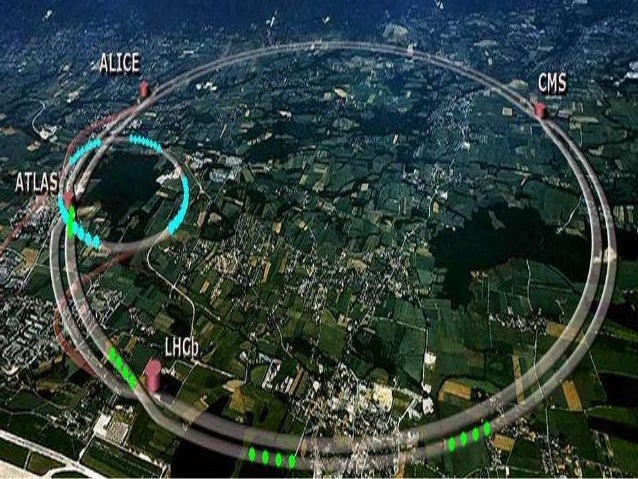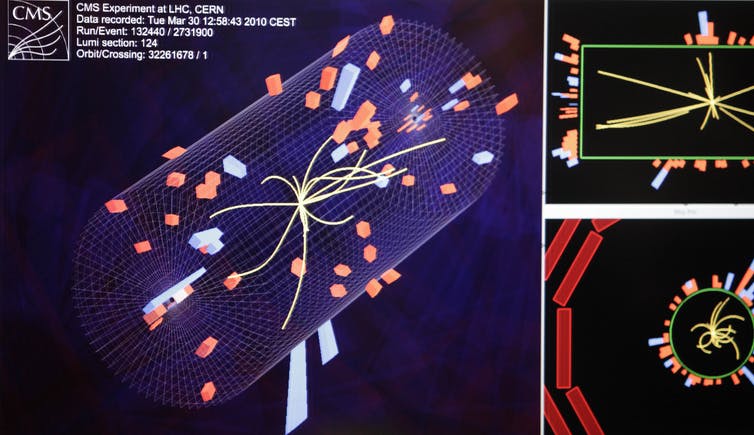LARGE HADRON COLLIDER
{LHC -PARTICLE ACCELERATOR }

The Large Hadron Collider (LHC) is the world’s largest and most powerful particle accelerator. It first started up on 10 September 2008, and remains the latest addition to CERN’s accelerator complex. The LHC consists of a 27-kilometre ring of superconducting magnets with a number of accelerating structures to boost the energy of the particles along the way.
COMPONENTS:

1} Inside the accelerator, two high-energy particle beams travel at close to the speed of light before they are made to collide. The beams travel in opposite directions in separate beam pipes – two tubes kept at ultrahigh vacuum.
2} They are guided around the accelerator ring by a strong magnetic field maintained by superconducting electromagnets. The electromagnets are built from coils of special electric cable that operates in a superconducting state, efficiently conducting electricity without resistance or loss of energy.
3} This requires chilling the magnets to ‑271.3°C – a temperature colder than outer space. For this reason, much of the accelerator is connected to a distribution system of liquid helium, which cools the magnets, as well as to other supply services.
5}Thousands of magnets of different varieties and sizes are used to direct the beams around the accelerator. These include 1232 dipole magnets 15 metres in length which bend the beams, and 392 quadrupole magnets, each 5–7 metres long, which focus the beams. Just prior to collision, another type of magnet is used to "squeeze" the particles closer together to increase the chances of collisions.
6} The particles are so tiny that the task of making them collide is akin to firing two needles 10 kilometres apart with such precision that they meet halfway.All the controls for the accelerator, its services and technical infrastructure are housed under one roof at the CERN Control Centre.
From here, the beams inside the LHC are made to collide at four locations around the accelerator ring, corresponding to the positions of four particle detectors – ATLAS, CMS, ALICE and LHCb.
LARGER DIPOLE MAGNETS :
DURING PARTICLE COLLISION :

THE MAIN GOALS OF LHC :
The Standard Model of particle physics – a theory developed in the early 1970s that describes the fundamental particles and their interactions – has precisely predicted a wide variety of phenomena and so far successfully explained almost all experimental results in particle physics.. But the Standard Model is incomplete. It leaves many questions open, which the LHC will help to answer.
What is the origin of mass? The Standard Model does not explain the origins of mass, nor why some particles are very heavy while others have no mass at all. However, theorists Robert Brout, François Englert and Peter Higgs made a proposal that was to solve this problem. The Brout-Englert-Higgs mechanism gives a mass to particles when they interact with an invisible field, now called the “Higgs field”, which pervades the universe. Particles that interact intensely with the Higgs field are heavy, while those that have feeble interactions are light. In the late 1980s, physicists started the search for the Higgs boson, the particle associated with the Higgs field. In July 2012, CERN announced the discovery of the Higgs boson, which confirmed the Brout-Englert-Higgs mechanism. However, finding it is not the end of the story, and researchers have to study the Higgs boson in detail to measure its properties and pin down its rarer decays.
Will we discover evidence for supersymmetry? The Standard Model does not offer a unified description of all the fundamental forces, as it remains difficult to construct a theory of gravity similar to those for the other forces. Supersymmetry – a theory that hypothesises the existence of more massive partners of the standard particles we know – could facilitate the unification of fundamental forces.
What are dark matter and dark energy? The matter we know and that makes up all stars and galaxies only accounts for 4% of the content of the universe. The search is then still open for particles or phenomena responsible for dark matter (23%) and dark energy (73%).
Why is there far more matter than antimatter in the universe? Matter and antimatter must have been produced in the same amounts at the time of the Big Bang, but from what we have observed so far, our Universe is made only of matter.
How does the quark-gluon plasma give rise to the particles that constitute the matter of our Universe? For part of each year, the LHC provides collisions between lead ions, recreating conditions similar to those just after the Big Bang. When heavy ions collide at high energies they form for an instant the quark-gluon plasma, a “fireball” of hot and dense matter that can be studied by the experiments.
REF : LHC , CERN

nice
ReplyDeletesuper dr
ReplyDelete